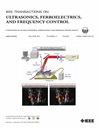Displacement Tracking Techniques in Ultrasound Elastography: From Cross Correlation to Deep Learning
IF 3
2区 工程技术
Q1 ACOUSTICS
IEEE transactions on ultrasonics, ferroelectrics, and frequency control
Pub Date : 2024-06-06
DOI:10.1109/TUFFC.2024.3410671
引用次数: 0
Abstract
Ultrasound elastography is a noninvasive medical imaging technique that maps viscoelastic properties to characterize tissues and diseases. Elastography can be divided into two classes in a broad sense: strain elastography (SE), which relies on Hooke’s law to delineate strain as a surrogate for elasticity, and shear-wave elastography (SWE), which tracks the propagation of shear waves (SWs) in tissues to estimate the elasticity. As tracking the displacement field in the temporal or spatial domain is an inevitable step of both SE and SWE, the success is contingent on the displacement estimation accuracy. Recent reviews mostly focused on clinical applications of elastography, disregarding advances in displacement tracking algorithms. Here, we comprehensively review the recently proposed displacement estimation algorithms applied to both SE and SWE. In addition to cross correlation, block-matching-based (i.e., window-based), model-based, energy-based, and deep learning-based tracking techniques, we review large and lateral displacement tracking, adaptive beamforming, data enhancement, and noise-suppression algorithms facilitating better displacement estimation. We also discuss the simulation models for displacement tracking validation, clinical translation and validation of displacement tracking methods, performance evaluation metrics, and publicly available codes and data for displacement tracking in elastography. Finally, we provide experiential opinions on different tracking algorithms, list the limitations of the current state of elastographic tracking, and comment on possible future research.超声弹性成像中的位移跟踪技术:从交叉相关到深度学习
超声弹性成像技术是一种非侵入性医学成像技术,通过绘制粘弹性特性图来描述组织和疾病的特征。从广义上讲,弹性成像可分为两类:应变弹性成像(SE)和剪切波弹性成像(SWE),前者依靠胡克定律来确定应变,作为弹性的代用指标;后者则跟踪剪切波在组织中的传播来估计弹性。由于在时间或空间域跟踪位移场是 SE 和 SWE 的必然步骤,因此其成功与否取决于位移估计的准确性。近期的综述大多集中于弹性成像的临床应用,而忽略了位移跟踪算法的进展。在此,我们全面回顾了最近提出的应用于 SE 和 SWE 的位移估计算法。除了交叉相关、块匹配(即基于窗口)、基于模型、基于能量和基于深度学习的跟踪技术外,我们还综述了大位移和横向位移跟踪、自适应波束成形、数据增强和噪声抑制算法,以促进更好的位移估计。我们还讨论了位移跟踪验证的模拟模型、位移跟踪方法的临床转化和验证、性能评估指标以及弹性成像中位移跟踪的公开可用代码和数据。最后,我们就不同的跟踪算法提供了经验意见,列出了弹性成像跟踪现状的局限性,并对未来可能的研究发表了评论。
本文章由计算机程序翻译,如有差异,请以英文原文为准。
求助全文
约1分钟内获得全文
求助全文
来源期刊
CiteScore
7.70
自引率
16.70%
发文量
583
审稿时长
4.5 months
期刊介绍:
IEEE Transactions on Ultrasonics, Ferroelectrics and Frequency Control includes the theory, technology, materials, and applications relating to: (1) the generation, transmission, and detection of ultrasonic waves and related phenomena; (2) medical ultrasound, including hyperthermia, bioeffects, tissue characterization and imaging; (3) ferroelectric, piezoelectric, and piezomagnetic materials, including crystals, polycrystalline solids, films, polymers, and composites; (4) frequency control, timing and time distribution, including crystal oscillators and other means of classical frequency control, and atomic, molecular and laser frequency control standards. Areas of interest range from fundamental studies to the design and/or applications of devices and systems.

 求助内容:
求助内容: 应助结果提醒方式:
应助结果提醒方式:


